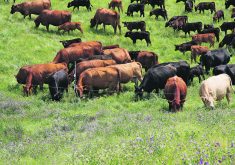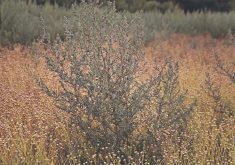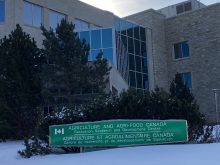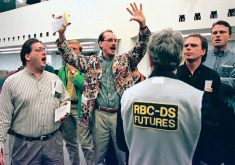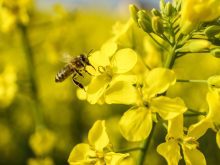Son of NEP
We should believe Ottawa when they deny any devious thoughts of raiding Alberta’s treasury. Instead, they can wash their hands while Kyoto, basically a foreign protocol, will do their dirty work for them.
Kyoto is back as the European Union traded Russia’s backing of Kyoto for their backing of Russia to join the World Trade Organization, which the Kremlin has eyed since 1993.
The requirements to legalize Kyoto have now been met – 55 countries representing 55 percent of the world’s greenhouse gas emissions have signed on. Of the remaining major industrial countries, the United States, China and India have not signed.
Read Also
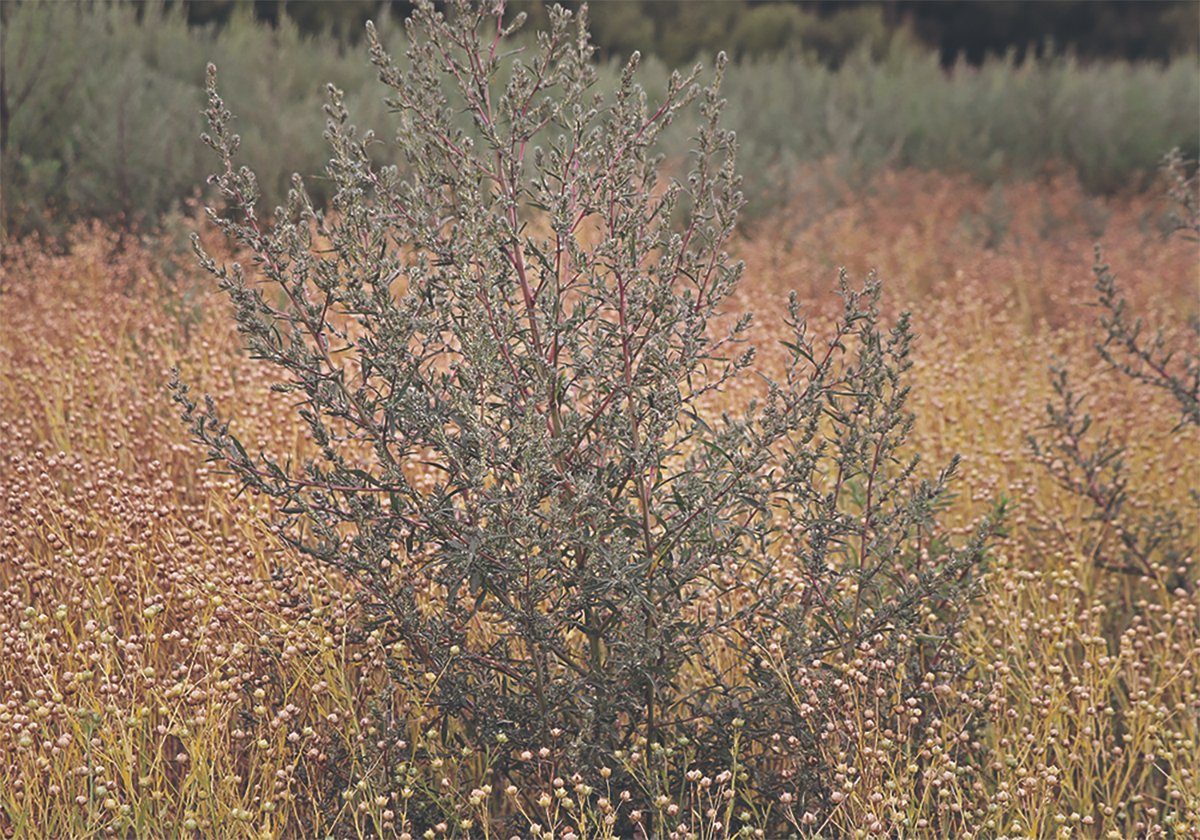
Kochia has become a significant problem for Prairie farmers
As you travel through southern Saskatchewan and Alberta, particularly in areas challenged by dry growing conditions, the magnitude of the kochia problem is easy to see.
So Alberta and to a lesser extent B.C. and Saskatchewan had better be ready for the Son of NEP (National Energy Program circa 1980.)
Just as the British Tea Tax (Boston Tea Party) in 1773 started the Americans towards independence, the Kyoto accord will be the spark that will eventually result in the Republic of Western Canada.
At this point it will be a race between Quebec and Western Canada as to who will separate first.
Realistically, a united Canada has not been an option since the quiet revolution in Quebec of the 1960s and the resulting Ottawa response starting with Pierre Trudeau.
Over subsequent years, there has been a growing separation in viewpoints and values between East and West. It appears that Kyoto will be the defining issue of this political process.
– Ace Cetinski,
Sherwood Park, Alta.
Buy Canada back
The consequences of foreign/American ownership of beef packing plants must now be clear to everyone.
As Canadian cattle producers are going broke, American cattle prices have never been better and American owned transnational beef packing plants are doing very well. Boy, isn’t it good to have foreign investment to stimulate the economy?
The questions that usually aren’t answered by investment promoters are whose economy and at what price?
It is also easy to see why many producers are unwilling to allow American hunters to hunt on their land this year. If Canadian beef isn’t safe for American consumers to eat, how in the world can anyone justify that it is safe to eat wildlife, deer, moose or elk?
It appears that Americans have once again been caught with their foot in their mouth. More Canadian producers are now recognizing the fact.
It is also relatively easy to see how Canada has found itself in this dilemma.
First it thought the American beef market was our answer for exporting Canadian beef. Beef producers depended upon our friend the U.S. too much.
Secondly, they believed that Canada’s foreign ownership laws were restricting our economy because of lower foreign investment opportunities by investors who resided outside of Canada. Canadian control of the beef industry has now been virtually eliminated. I wonder if anyone still believes that investment theory?
Unfortunately though, it appears the Canadian government has learned little, as it is now selling off its remaining shares in Petro Canada with estimates of only about a third of the shares retained by Canadians.
If we are to keep Canada, Canadians, it appears we will have to take ownership from the producers upward, as governments almost appear useless in protecting Canadian’s ownership of the economy and Canada’s sovereignty.
– Roy Atkinson,
Landis, Sask.
Stress and AESA
Municipal districts and counties in Alberta are increasingly being mandated by their respective Agricultural Service Boards and councils to serve the extension needs of agricultural producers.
This includes the delivery of the Alberta Environmentally Sustainable Agriculture (AESA) farm-based extension program. It is a role taken very seriously. In the course of our activities up here in the Peace country, I submit columns to the regional weeklies in our municipalities for publication.
While writing one up recently it dawned on me that rural readers, regardless of where they may be, might like to read it or at least some of it.
You see, I was talking to a sometimes cranky but always level-headed guy here in the Peace region who I use as a sounding board.
This cranky guy got to pressuring me about stress on the farm and why I never write about it. He perplexed me enough that I even lost some sleep over it, pondering as to what stress on the farm has to do with AESA. Just how in God’s green space did he expect me to make that connection?
Maybe it takes being a little tired and cranky once in awhile yourself in order to make some of these realizations, because as usual, he was right. There is a very real and direct connection to stress in the Alberta farm and ranch community and AESA.
Much of what’s causing stress down on the farm and back at the ranch these days such as “no time,” “no money,” “BSE crisis” and “the weather, good or bad” are the main barriers cited to adopting an environmentally sustainable practice in Alberta. All are real and valid causes of huge amounts of associated stress.
Is there a solution to any one of these wrapped up in a neat and tidy beneficial management practice? We can only wish.
Is there such a thing, however, as a practice to address coping with stress down on the farm or back at the ranch? In my opinion, such a practice would have to include talking it out. When trying to cope with the weight of it all, problems, whatever they may be, are not as hard on you if you get them off your chest regularly.
If something happening with you or to you is getting to you, find somebody that you can talk to about it and do so right now.
You are not alone in having problems causing loads of stress. Consider that sharing your burden will lighten the load. We’ll work on adopting environmentally sustainable agricultural practices down on the farm or back at the ranch soon. We’ll just leave it for another day.
As they say here, “no worries.”
– Gerard Aldridge,
Rural Extension Specialist for Municipal Districts of Fairview, Peace and Clear Hills,
Fairview, Alta.
South or east?
South or east? I think the choice is easy.
What do we see when we look south? A closed border for live cattle. When the border will reopen is anybody’s guess.
Most American farmers like to keep it that way and who can blame them? They get record high prices for their cattle.
If sometime in the future the border opens up, it will be only for young animals, and don’t be surprised that some U.S. farm group will argue that the Canadian aid package amounts to an unfair subsidy and therefore the U.S. government should levy an import duty on Canadian cattle coming into the U.S.
Don’t forget the country-of-origin labelling law if implemented. It surely won’t help Canadian beef in American stores.
Now let’s look east. What we see is a big shortage of beef in Japan, Korea and other Asian nations due to the lack of import of North American beef and (because of) the avian flu.
I am convinced that we can get access to those markets by offering 100 percent BSE free beef. To do that we have to implement the same system as Europe, where every animal is tested for BSE.
European nations test more animals per day than the 30,000 Canada plans to test in total for the year 2005.
If they can do it in Europe, surely we can do it in Canada too.
A friend of mine who farms in the Netherlands told me recently that Russia opened the border for meat and meat products from Holland, including meat from older cows.
He also told me that the cost of the BSE test is 26 euros per animal (about $40 Cdn.)
The federal government should share in the cost of the labs and testing. I know that scientists say that to test every animal is not necessary but the Asian consumers demand it.
So we have a choice. We can sit on our hands, look south and hope that someday the U.S. border reopens, or we can look to the Far East, test every slaughtered animal and get access to the Japanese, Korean and the huge developing Chinese markets.
I am looking east. What is your choice?
– Gerlof de Jong,
Souris, Man.




